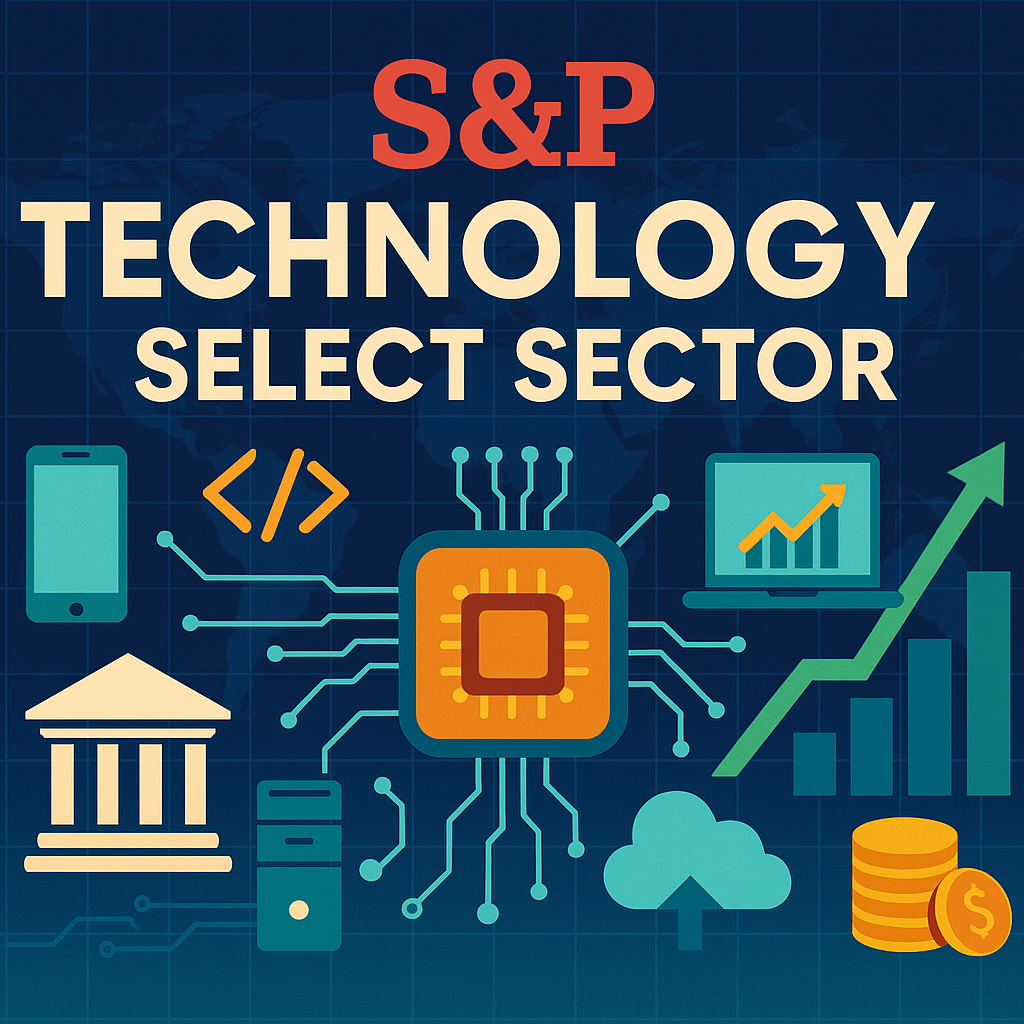Tracks the information-technology members of the S&P 500—spanning software platforms, semiconductor titans, cloud-service enablers and hardware innovators—so investors can target U.S. large-cap tech with one ticker ( IXT for the price version, XLK for the ETF).

1. Why This Index Matters
To start with, technology now generates about a quarter of S&P 500 earnings and roughly 30 % of its market value. However, some allocators want pure tech beta without health-care or consumer stocks tagging along. The S&P Technology Select Sector Index solves that need: it carves out only those S&P 500 constituents carrying a GICS Information Technology code, then weights them by free-float market cap—therefore aligning exposure with real money at risk.
2. Construction Highlights
| Rule | Detail |
|---|---|
| Parent Universe | S&P 500 (≈ 500 large-caps) |
| Sector Screen | GICS 45 – Information Technology |
| Weighting Method | Free-float market cap; single-stock weight typically capped at ≈ 22 % at quarterly review |
| Rebalance Cadence | Quarterly (Mar · Jun · Sep · Dec) |
| Series Offered | Price (IXT), Net-Total Return (IXTTR) |
Consequently, mega-caps move the index, yet the quarterly cap prevents any one company from overwhelming its peers.
3. Snapshot (May 2025)
| Metric | Figure |
|---|---|
| Constituents | 65 |
| Index Level (price) | 3 945 |
| Free-Float Market Cap | US $15.4 trillion |
| Dividend Yield | 0.9 % |
| Top Weights | Microsoft 10.9 %, Apple 10.5 %, Nvidia 6.7 %, Broadcom 4.9 %, Adobe 4.1 % |
| Sub-Industry Mix | Software 30 %, Semiconductors 29 %, IT Services 18 %, Hardware & Peripherals 16 %, Fintech/Payments 7 % |
Because Microsoft and Apple each exceed 10 %, they hit the index’s special 10–21 % cap rule—a mechanism that gradually trims them if they climb above 21 % before the next rebalance.
4. Recent Performance (Total Return, USD)
| Year | Index | S&P 500 | Key Catalyst |
|---|---|---|---|
| 2022 | –27 % | –18 % | Rate-driven multiple compression |
| 2023 | +55 % | +24 % | Generative-AI cloud spending |
| 2024 | +24 % | +14 % | Smartphone replacement cycle, chip shortages |
| YTD 2025 | +10.1 % | +6.8 % | Edge-AI boom, sovereign-cloud migration |
Thus, volatility hovers near 22 %, higher than the broad market yet rewarding during growth phases.
5. How Investors Use It
- Targeted Allocation: Overweight tech via XLK, the ETF that physically tracks the index.
- Sector Rotation: Macro desks add XLK when growth accelerates and trim when rate risk looms.
- Benchmarking: U.S. tech fund managers measure alpha relative to this yard-stick rather than the full S&P 500.
- Derivatives Hedging: Cboe options on XLK allow precise downside protection during earnings season.
6. Strengths & Limitations
| Strengths | Limitations |
|---|---|
| Simple, transparent, deep history (since 1998) | Mega-cap dominance—top 5 stocks ≈ 37 % of weight |
| Quarterly caps curb single-name risk | Excludes communication-services giants like Alphabet and Meta, which many investors still view as “tech” |
| Liquidity—ETF and options trade billions daily | Purely U.S.; no exposure to Taiwanese fabs or European semiconductor equipment |
7. Themes to Watch
- AI at the Edge: Smartphone and PC inference chips could lift semiconductor sleeve above 32 % by 2026.
- Software Usage-Based Pricing: If consumption models gain traction, cloud providers’ earnings beta will rise.
- On-shoring Incentives: CHIPS Act fabs coming online may push hardware share higher at future rebalances.
- Antitrust Scrutiny: FTC and EU Digital Markets Act enforcement could cap mega-cap weight growth, benefiting mid-tier software names.
Key Takeaways
The S&P Technology Select Sector Index condenses 65 U.S. tech leaders into one float-weighted benchmark. With a 3 945 price level, 0.9 % yield and high correlation to innovation cycles, it remains Wall Street’s definitive gauge for large-cap American technology exposure—ideal for tactical plays, strategic core sleeves and performance benchmarking alike.